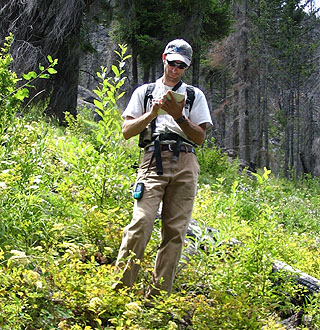
Shannon & Wilson
Specialty: Geotech and environmental services related to transportation and buildings
Management:
Gerard Buechel, president
Founded: 1954
Headquarters: Seattle
2004 revenues:
$15.7 million
Projected 2005 revenues: $17.8 million
Current projects:
Alaskan Way Viaduct and Seawall replacement; Sound Transit light rail and commuter rail; various remediation projects at building sites in downtown Seattle

Photo courtesy Shannon & Wilson Shannon & Wilson biologist Cliff Palmer recently completed a plant and animal survey in Eastern Washington for an EIS. |
Shannon & Wilson senior vice president Dan Clayton says new techniques, new technologies and new politics are changing the Seattle-based firm’s environmental work.
Given the large areas involved in miles-long projects like Sound Transit’s light-rail line or replacing the Alaskan Way Viaduct, the firm has turned to risk-based assessments of environmental hazards, avoiding the “pretty extreme” level of detail that the standard approach would require. Shannon & Wilson uses historical records to determine what types of businesses have occupied particular sites over time. Such screening reduces the number of physical explorations, and dollars, needed.
Risk-based approaches
Cleanup work is shifting in a similar way, according to Clayton.
“It’s becoming more risk-based, rather than some pointy-headed scientific approach that was based on a list of very, very conservative assumptions,” he says.
Between the risk-based approaches and new technologies like digital imaging, remote imaging, and ever more powerful computers, environmental work is becoming more effective and less expensive, according to Clayton.
“We’re able to do a lot more a lot more quickly,” he says.
Even so, Clayton says business owners are recognizing that cleanup remains extremely costly and are focusing more on preventing pollution or even shunning development on some polluted sites.
“Any parking lot in downtown Seattle is a parking lot because it has a contamination issue,” he says.
More homeland security
While Shannon & Wilson has been doing well and expects to increase its environmental staff about 10 percent this year, Clayton says tight government budgets and less aggressive regulators have cut into the firm’s revenues.
“We’ve certainly seen our military actions depleting government coffers for doing environmental remediation,” he says. “There’s a tendency toward relaxing the enforcing of regulations, and a reluctance on the part of owners to do anything if the regulations aren’t being enforced,” he says.
At the same time, homeland security spending has boosted the demand for hazardous materials surveys and environmental work associated with upgrading critical infrastructure.
The markets are strong enough now that Shannon & Wilson is having a hard time finding engineers with the desired 5 to 10 years of experience.
Despite some constraints, Clayton expects the environmental sector to remain very strong for the next couple of years as environmental pressures and awareness continue to build.
“It’s an exciting time to be working in the field because there are so many forces pulling in so many directions,” he says.